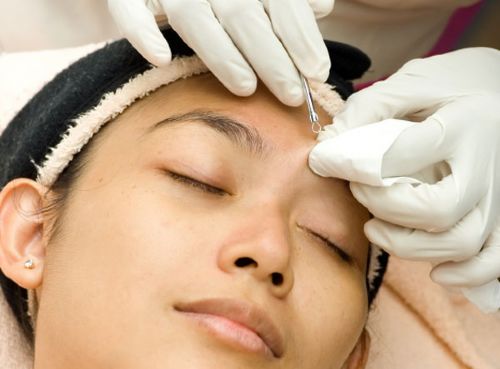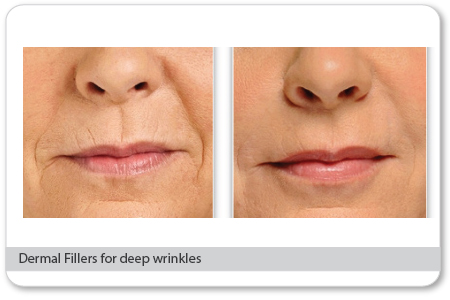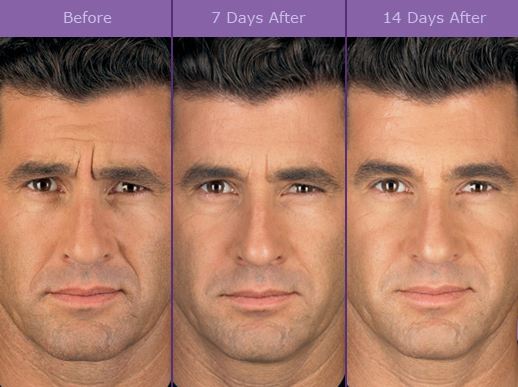Look For The Gloves.
The esthetician should always wear gloves when performing extractions. The esthetician is dealing with body fluids, and if she doesn’t wear gloves, it means she’s not that clean or careful in her work.
Fingers Or Extraction Tool?
Estheticians can remove blackheads with their index fingers, covered in cotton, by applying pressure to either side of the blackhead and gently coaxing it from the follicle. Some estheticians prefer to use a stainless steel tool that has a loop at one end. It’s faster and can get into awkward places, but some clients find it hurts more.
Whiteheads Are Harder To Remove.
Whiteheads have a layer of dead skin cells that have grown over the plug of sebum. The esthetician has to make an opening in the skin with a lancet, a small, sharp, surgical blade that comes in a sterile packet. These are harder to remove and take more time. The use of lancets is illegal in some states, and some resort and hotel spas don’t allow their estheticians to use them.
Extractions Can Hurt.
Different people have different pain thresholds. People with thicker, oiler skin are usually less sensitive, while people with thinner skin are usually more sensitive. Estheticians also vary in how aggressive they are. Speak up if it hurts too much.
Extractions Can Cause Damage If Not Done Correctly.
Too much pressure can cause broken capillaries on people with sensitive, reddened skin (called couperouse). It can cause dark spots called hyperpigmentation on people with black skin. And inflamed areas should not be extracted, because the infection might spread.
Don’t Have An Extraction Marathon.
Extractions shouldn’t last more than ten minutes. If you have a lot of blackheads and whiteheads, don’t expect to get rid of them in one session. Too many extractions at one time can be traumatic to the skin.
Extractions Are Important!
If you have acne or blemishes, extractions are the most important part of the facial for you. Once the follicles are cleared out, your skin should start to improve. You may want to get facials every two weeks until your skin is clear. It’s also important to follow up with the right products and a good home skin care routine.
More
Laser Hair Removal
In this method, a laser destroys hair follicles with heat.
Sometimes it is recommended that a topical anesthetic product be used before a laser hair removal procedure, to minimize pain. In these cases, FDA recommends that consumers discuss with a medical professional the circumstances under which the cream should be used, and whether the use is appropriate.
Those who decide to use a skin-numbing product should follow the directions of a health care provider and consider using a product that contains the lowest amount of anesthetic drugs possible. FDA’s Center for Drug Evaluation and Research has received reports of serious and life-threatening side effects after use of large amounts of skin-numbing products for laser hair removal.
Side effects of laser hair removal can include blistering, discoloration after treatment, swelling, redness, and scarring. Sunlight should be avoided during healing after the procedure.
Epilators: Needle, Electrolysis, and Tweezers
Needle epilators introduce a fine wire close to the hair shaft, under the skin, and into the hair follicle. An electric current travels down the wire and destroys the hair root at the bottom of the follicle, and the loosened hair is removed with tweezers.
Medical electrolysis devices destroy hair growth with a shortwave radio frequency after a thin probe is placed in the hair follicle. Risks from these methods include infection from an unsterile needle and scarring from improper technique. Electrolysis is considered a permanent hair removal method, since it destroys the hair follicle. It requires a series of appointments over a period of time.
Tweezer epilators also use electric current to remove hair. The tweezers grasp the hair close to the skin, and energy is applied at the tip of the tweezer. There is no body of significant information establishing the effectiveness of the tweezer epilator to permanently remove hair.
Depilatories
Available in gel, cream, lotion, aerosol, and roll-on forms, depilatories are highly alkaline (or, in some cases, acidic) formulations that affect the protein structure of the hair, causing it to dissolve into a jellylike mass that the user can easily wipe from the skin. Consumers should carefully follow instructions and heed all warnings on the product label.
Waxing, Sugaring, and Threading
Unlike chemical depilatories that remove hair at the skin’s surface, these methods pluck hairs out of the follicle, below the surface.
With waxing, a layer of melted wax is applied to the skin and allowed to harden. (Cold waxes, which are soft at room temperature, allow the user to skip the steps of melting and hardening.) It is then pulled off quickly in the opposite direction of the hair growth, taking the uprooted hair with it. Labeling of waxes may caution that these products should not be used by people with diabetes and circulatory problems. Waxes should not be used over varicose veins, moles, or warts. Waxes also shouldn’t be used on eyelashes, the nose, ears, or on nipples, genital areas, or on irritated, chapped, or sunburned skin. As with chemical depilatories, it can be a good idea to do a preliminary test on a small area for allergic reaction or irritation.
Sugaring is similar to waxing. A heated sugar mixture is spread on the skin, sometimes covered with a strip of fabric, and then lifted off to remove hair. Threading is an ancient technique in which a loop of thread is rotated across the skin to pluck the hair. All of these techniques may cause skin irritation and infection.
Shaving
Shaving hair only when it’s wet, and shaving in the direction in which the hairs lie, can help lessen skin irritation and cuts. It’s important to use a clean razor with a sharp blade. Contrary to popular belief, shaving does not change the texture, color, or growth rate of hair.
More
What treatment is right for me? In other words, don’t ask the doctor for a specific procedure. Instead, explain the issues that need to be addressed and let the doctor offer the solution. ASDS doctors have extensive experience doing a variety of aesthetic treatments.
Is the specific laser, device or technique appropriate for my skin type? ASDS doctors know that cosmetic procedures and treatments are not one-size-fits-all. Each patient is evaluated for skin type as part of the initial evaluation.
How much does it cost? As a rule, almost all cosmetic surgery is considered “elective” and is not typically covered by insurance plans. Although some spas, salons and walk-in clinics offer cosmetic medical procedures at lower prices, consumers should be aware that “these discounted prices could put your health at risk as a result of the provider’s inadequate training and lack of expertise.”
What should I do to prepare for the treatment? Carefully following the physician’s guidelines before the procedure can greatly impact the final results.
Have you reviewed my medical history? Information that a patient may think is unrelated to their treatment may in fact play a key role in recovery or the length of a procedure. Patients should be sure to disclose their specific surgery history, any allergies and any pharmaceuticals, over-the-counter drugs or herbal supplements that they are taking at the time of their procedure.
What are my pain management and anesthesia options? To help avoid the risks associated with general anesthesia, ask the physician about alternative pain management options. Many techniques that are performed in a physician’s office can be done under local anesthesia, eliminating some side effects such as nausea and headaches that often accompany general anesthesia. Using a short-term local anesthesia may also eliminate complications that are sometimes related to general anesthesia, including allergies and heart problems.
What are the risks? Discuss the potential side effects of the proposed treatment, how often they occur and how they will be handled if they do occur.
What should I expect after the procedure is performed? Besides a discussion about the short-term and long-term effects, activity restrictions and the expected recovery period, doctors should share before-and-after photos of previous patients and discuss realistic expectations.
More
Liposuction is the leading option to diminish the appearance of stubborn bumps and lumps from localized fat and help sculpt areas to appear more toned and trim. Tumescent liposuction using local anesthesia as developed and performed by dermatologic surgeons is extremely safe. However, as with any invasive procedure, liposuction has risks. Some simple steps can help prevent potential complications before and after a liposuction procedure. Researching the procedure and doctor, having realistic expectations, using local anesthesia and following post-operative directions are just a few guidelines that will help to ensure the patient receives the best results.
ASDS offers some additional tips to ensure a positive result:
Do’s:
- Do your research: There is a lot to consider when undergoing liposuction. Choosing a dermatologic surgeon at a reputable location is very important and could help to decrease complications.
- Do maintain a healthy weight before surgery: Liposuction is a procedure for shaping the body by removing localized fat in areas such as the abdomen, thighs, arms or neck. For best results, candidates should be close to normal-weight with firm, elastic skin. This is not a weight loss procedure.
- Do understand your options: There are several options to liposuction surgery. Tumescent liposuction, the safest procedure, uses local anesthesia, injecting the fat with a large amount of anesthetic liquid causing it to become firm, making the removal of fat easy and painless while leaving patients less bruised. Ultrasonic and laser-assisted liposuction technique liquefies fat upon removal, decreasing recovery time. These are sometimes useful adjuncts. It’s important that you speak with your doctor to choose the right procedure for you.
- Do follow post-operative directions carefully: Doctors make suggestions after surgery to further avoid complications. Moderate physical activity, such as walking, the day after surgery may reduce the risk of clotting. Also, in some cases, compression garments should be worn around the treated area to reduce swelling.
Don’ts:
- Don’t expect to look “skinny” the day after surgery: You will always look better immediately after a procedure but will not realize the final result for several months.
- Don’t hesitate to ask questions: Before a consultation with a dermatologic surgeon a patient should be prepared with a list of questions for their doctor. Questions should help the patient understand the liposuction process, what to expect after the procedure and learn more about the doctor’s training and experience.
- Don’t continue over-the-counter supplements: Products such as aspirin, vitamin E and some herbal products slow blood clotting. Additionally, some anti-inflammatory medications can increase the chances of bleeding during surgery. Prior to surgery, the doctor will discuss any medications and supplements you are taking and which ones should be discontinued.
- Don’t assume all areas are treatable: Most, but not all, body parts are amenable to treatment. The most popular areas include the neck, chest, arms, waist, hips, abdomen, buttocks, thighs, knees and ankles. Your dermatologic surgeon will tell you if you are a good candidate for the surgery.
More
By Sandra Tyler
16 Mar, 2015
Botox, Fillers, Juevederm, Misc, News & Blogs
botox, collagen, Cosmetic Surgery, facial aging, fat transfer, fillers, hyaluronic acid, juevederm, non surgical, restelyn, wrinkles
Fillers are popular. To help you decide whether this treatment is right for you and to have the treatment performed safely, the AAD provides the following facts.
What happens when I get a filler?
The procedure varies with the filler your dermatologist will use, the part of the body to be treated, and your medical history. Here are some general guidelines about what you can expect:
- Most filler treatments take between 15 and 30 minutes and require one office visit.
- Before getting the injections, you may need ice, an anesthetic applied to the skin, or a nerve block (an injection). This varies with the filler and area to be treated. Hands generally do not need anesthesia; lips often require a nerve block.
- Your dermatologist will inject the filler into the area, often giving you several injections to produce the best results.
- You may feel a stinging or burning sensation as the filler is injected.
- A few fillers require allergy testing to make sure you do not have an allergic reaction.
- If you need allergy testing, you must wait for the results from the allergy test before you can get the filler.
- If your own fat will be used as a filler, the entire treatment can often be completed in one day. You will first have a procedure called tumescent liposuction, which safely removes a small amount of fat from another area of your body. The fat removed from your body is then processed so that it can be injected into the area that needs more fullness.
What must I do after getting a filler?
Most patients can return to their everyday activities after leaving the office.
To reduce any redness and swelling from the injections, your dermatologist may recommend icing the area for 15 to 20 minutes before you leave.
Before you leave the office, you should be able to apply makeup.
After leaving the office, you should:
- Wait until the next day to exercise or do any other strenuous activity.
- Stay out of the sun and do not use a tanning bed or other type of indoor tanning.
- Avoid touching the treated area for three days, unless you receive instructions to massage the area.
- One filler, poly-L-lactic acid, requires you to gently massage the treated area for about 5 minutes several times a day for 1 to 2 weeks. Your dermatologist will tell you if you need to massage the area.
Is there downtime?
This varies with the filler. Most fillers do not cause downtime. Be sure to ask your dermatologist whether you will have downtime.
When will I see results after getting a filler?
This also varies with the filler. Most fillers fill the skin, so they produce immediate — or close to immediate — results. A filler also can stimulate your body to produce collagen, but this takes time.
Most fillers offer immediate results
| Filler |
When see results |
| Collagen |
Immediate |
| Hyaluronic acid gel |
Immediate |
| Calcium hydroxyl apatite |
Immediate |
| Poly-L-lactic acid |
2 or 3 weeks |
| Fat taken from your body |
Immediate |
| PMMA (polymethylmethacrylate) |
Immediate |
You may see other fillers advertised. All fillers listed above have been approved by the U.S. Food and Drug Administration (FDA), except for self-donated fat. This filler does not require FDA approval because it comes from your own body.
Will I look natural?
To get natural-looking results, the person injecting the filler must have expertise in placing the filler.
Dermatologists recommend not overdoing fillers. Your results will look more natural with a conservative approach. For example, patients who have very thin lips should not get dramatically fuller lips. Creating fuller lips in these patients could be extremely unflattering because the lips might start to resemble a duck’s bill.
How long will the results from fillers last?
Most fillers offer temporary results and require repeat treatments to maintain the results.
Temporary fillers offer one key advantage. These can be injected as needed to replace lost fullness. This is advantageous because no matter what we do, our skin continues to age.
How long fillers typically last
| Filler |
How long it lasts |
| Collagen |
2 to 3 months (often longer when treating scar) |
| Hyaluronic acid gel |
4 to 12 months |
| Calcium hydroxylapatite |
6 months to 1 year |
| Poly-L-lactic acid |
1 to 3 years |
| Fat taken from your body |
1 to 3 years (often longer when treating a scar) |
| PMMA (polymethylmethacrylate) |
permanent |
You should ask your dermatologist how long the recommended filler should last in the area you want treated.
When is it safe to get another treatment?
If you get a temporary filler, you can usually have another treatment when the signs of aging reappear.
What are the possible side effects?
After receiving filler injections, some patients have minor, temporary side effects where they were injected. You may have:
- Redness
- Swelling
- Tenderness
- Bruising (occasionally)
These side effects tend to clear within 7 to 14 days — if not earlier.
Serious side effects are more likely when the person injecting the filler does not have adequate medical training and experience. To protect your health, you should never get filler injections in a non-medical setting, such as non-medical spa, salon, or someone’s home.
When fillers are injected in a non-medical setting or by an inexperienced provider, reports of more serious side effects increase dramatically. These side effects include:
- Lumps.
- Ridges.
- Over-filled areas.
- Allergic reaction.
- Skin discoloration.
- Infection.
- Severe swelling.
What is the safety record for fillers?
This is one of the safest cosmetic treatments available. For years, dermatologists have been refining the use of fillers to diminish signs of aging. Today, dermatologists safely treat people of many ages and all skin colors.
More
Ear deformities occur in a number of conditions. Some patients are born with absent (microtia), protruding or drooping ears, due to weak or poorly formed cartilage. Traumatic deformities of the ear also occur due to trauma (e.g. car wreck or dog bite) or torn earlobes. Deformity of the ears may cause social anxiety and may make children vulnerable to teasing. Regardless of the origin of the ear deformity, these ear conditions can be surgically corrected. These procedures do not alter the patient’s hearing, but they may improve appearance and self-confidence.
Can Ear Deformities Be Corrected?
Formation of the ear during development is a complex choreography of moving skin and adjacent soft tissue to give rise to the different parts of the ear. If this process is interrupted, various differences in ear shape can occur, with the most severe being absence of the ear (and possibly the ear canal) called microtia, to mild folding differences of the ear. The “fold” of hard, raised cartilage that gives shape to the upper portion of the ear does not form in all people. This is called “lop-ear deformity,” and it is inherited. The absence of the fold can cause the ear to stick out or flop down (see below). Some infants are born without an ear canal and hearing can be restored with a bone-anchored hearing aid or it can be surgically opened, and the outer ear reshaped to look like the other ear. Those who are born without an ear (microtia), or lose an ear due to injury, can have an artificial ear surgically attached for cosmetic reasons. These are custom formed to match the patient’s other ear. Alternatively, rib cartilage or a biomedical implant, in addition to the patient’s own soft tissue, can be used to construct a new ear.
Surgical Correction of Prominent Ears That Lack Folds
To correct this problem, the surgeon places permanent stitches in the upper ear cartilage and ties them in a way that creates a fold and props the ear up. Scar tissue will form later, holding the fold in place. Corrective surgery, called otoplasty, should be considered on ears that stick out more than 4/5 of an inch (2 cm) from the back of the head. It can be performed at any age after the ears have reached full size, usually at five or six years of age. Having the surgery at a young age has two benefits: the cartilage is more pliable, making it easier to reshape, and the child will experience the psychological benefits of the cosmetic improvement. However, a patient may have the surgery at any age.
The surgery begins with an incision behind the ear, in the fold where the ear joins the head. The surgeon may remove skin and cartilage or trim and reshape the cartilage. In addition to correcting protrusion, ears may also be reshaped, reduced in size, or made more symmetrical. The cartilage is then secured in the new position with permanent stitches which will anchor the ear while healing occurs.Typically otoplasty surgery takes about two hours. The soft dressings over the ears will be used for a few weeks as protection, and the patient usually experiences only mild discomfort. Headbands are sometimes recommended to hold the ears in place for a month following surgery or may be prescribed for nighttime wear only.
Can Torn Earlobes Be Corrected?
Ear lobe trauma can occur related to tearing related to injury from small children grabbing the earring or having it caught on clothing or other objects. These tears can be easily repaired surgically, usually in the doctor’s office. In severe cases, the surgeon may cut a small triangular notch at the bottom of the lobe. A matching flap is then created from tissue on the other side of the tear, and the two wedges are fitted together and stitched. Earlobes usually heal quickly with minimal scarring. In most cases, the earlobe can be pierced again four to six weeks after surgery to receive light-weight earrings.
Does Insurance Pay for Cosmetic Ear Surgery?
Insurance usually does not cover surgery solely for cosmetic reasons. However, insurance may cover, in whole or in part, surgery to correct a congenital or traumatic defect. Before cosmetic ear surgery, discuss the procedure with your insurance carrier to determine what coverage, if any, you can expect.
More
By Sandra Tyler
13 Mar, 2015
Botox, Misc, News & Blogs
botox, brotox, enhancement procedure, face lift, facelift, freeze face, lifestyle lift, wrinkles
Ladies, you may be surprised to know what men talk about on “guy’s night out,” besides women and sports — “Brotox,” also commonly known to the rest of us as Botox (botulinumtoxin A). The long-time cosmetic enhancement procedure, often linked to women, has now reached a wide group of men who desire to appear more youthful. The number of men undergoing Brotox has gone up 10 percent from last year, but why? Amid fear of competition with younger folk in the workplace and in their personal lives.
“Any man’s afraid he’s gonna get bumped by somebody younger in business or personal life too. I think once he gets over the stigma of it being something feminine, I could see more men being drawn to it,” said an unidentified man.
A multitude of men are currently making more appointments to “freeze” time and hold onto their eternal youth through this age defying treatment, but does the “freezing” effect work? Botox injections contain the bacterium Clostridium botulinum that can block signals from the nerves to the muscles so the muscle can no longer contract, preventing the onset of wrinkles when injected. The treatment is used on forehead lines, crow’s feet, or lines around the eye, and frown lines. However, men and women, should note wrinkles caused by sun damage and gravity do not respond to Botox injections.
The Botox procedure takes only a few minutes, with no anesthesia required. Patients will start to see results anywhere from three to seven days when the procedure begins to take effect. It is advised to avoid alcohol at least one week before treatment, and to stop aspirin and anti-inflammatory medications two weeks before treatment in order to reduce bruising associated with Botox.
Men have begun to adopt a more open attitude toward cosmetic procedures and have become more aware of the treatments available to them, as the age range of men being treated has widened. The BRO culture has fostered recent trends like the Hipster beard transplant, and now Brotox. The desire to climb the career ladder and keep up with the “younger-looking” has become the crucial reason why men opt for Botox — it’s surgery-free. Now, both men and women, vie to be the youngest and most desired of them all.
More
http://
World News Videos | US News Videos
More
Kim Kardashian is boosting plastic surgeons’ bottom lines.
Two doctors’ organizations have tallied up the cosmetic procedures performed last year, and butt augmentation skyrocketed — as did a controversial surgery to reshape women’s genitals. Meanwhile, old-fashioned breast enlargement, still the most common cosmetic surgery, took a dip.
Surgeons say stars who celebrate their cabooses are fueling the surge, but critics contend it’s medical marketing that has convinced some Americans they need posterior padding at the cost of thousands of dollars and physical risks. Click Below to read more.
http://www.nbcnews.com/news/us-news/butt-augmentation-labiaplasty-rise-plastic-surgeons-say-n312996
More
Have you had a consult with Lifestyle Lift recently?
After helping Lifestyle Lift open in Orlando Florida several years ago and training some of their doctors, I am regretful to say that they have had the unfortunate and unexpected closing of the company. If you are still considering reducing the signs of aging through a mini facelift, please give us a call here at Artful Awakenings Cosmetic Surgery Center in historic downtown Melbourne. We would be happy to match or even reduce the previous price you were given. Don’t wait to call and schedule your free consultation today! 321-676-3101
More









